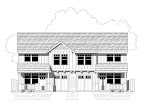It was a year ago that we promoted the Warmboard floor system as our choice of heating in homes. We have gotten comments about how expensive that floor system can be. Correct, materials and labor do make it an expensive alternative. Consider that you are removing a $4000-$5000 furnace and ductwork system. Also consider that the floor panels themselves act as the structural floor sheathing. For a 2000sf house you are saving another $1000 by not buying a couple loads of 3/4" T&G plywood. You will probably have to install a second water heater, or a larger water heater, as well as a manifold to handle your different zones.
Also consider this: If your home needs a 60,000 BTU furnace, would you install a 100,000 BTU just to be safe? No! Never! This is poor use of resources and your money. Likewise, would you install a larger radiant floor system than you need? Why? Radiant hydronic floor heat generates about 18-25 BTU/sf of floor. If your home needs 40,000 BTU to stay warm, then you would need to lay 2200sf of 18 BTU/sf system.
But many homes of 2200sf in size only need 30,000 BTU of heat (average NW home). If they are built well, air sealed well, and insulated better, that can be reduced to 20,000 BTU or less. Now do the math. You need 20,000 BTU and your system is 20 BTU/sf. Now you only need 1000sf of panels. This is less than half the floor area. Would you still lay the whole floor, just because? Why? This is akin to doubling your furnace size. Instead, save your money and lay the radiant system only where you need it. Do you need it in bedroom and linen closets? Probably not. Pantry? No. Kitchen? Probably not. The appliances in there create enough residual heat, unless you spend a lot of time cooking barefoot and want warm toes. Hallways and the laundry room could avoid it as well. Bathrooms don't need it under the fixtures. This could remove about 400sf. You could remove more by avoiding areas where furniture would permanently sit.
Since the panels are 4x8x1-1/8", they will fit seamlessly with standard 1-1/8" panels. In our previous example, we could cover half the floor with standard sheathing. Another consideration? With 1-1/8" floor sheathing, your floor joists could span 24" o.c. thereby saving you on framing materials.
And savings is what istockhouseplans is all about.
Tuesday, May 19, 2009
Subscribe to:
Post Comments (Atom)






No comments:
Post a Comment